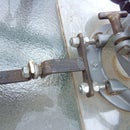Introduction: Tool Box Socket Trays
If your tool box is a mess with loose sockets rolling around, and you do not want to spend $$$$ on those commercially available organizers that waste sooo much space, this DIY idea may be just for you. And no welding is involved........this time.
All your materials can be scrounged. Keep your eye out for the re-useables on garbage day. Old stoves and dryers are good candidates for sheet metal in the 18Ga (.050 ") range. Even old furnaces and duct work (although lighter gauge steel) make good project materials and it is free. Donors feel good about stuff being re-used also...........have had help disassembling things at times.
The first step is to lay out your sockets, the ones you want to group, in the pattern you want them grouped in. Then measure the space they occupy and cut your sheet metal accordingly, leaving a little bit on the folded up sides to trim off later. That way you can ignore any "bend allowances" you would need to calulate if you were to cut the material to the exact size initially.
Layout some marks where you want the bends to occur, then get to work bending. If you have a sheet metal brake that you have already made up then great use it, if not you can do an acceptable job in your "mechanics" vise. Get some angle irons (free bed rails work OK) in your vise and have them extend out to the side of the jaws enough to accomodate the width of your bends, plus a bit to allow a clamp on the loose ends.
You now have your sides bent up and are ready to check the fit (of your sockets) and decide upon the height you need for those sides. Cut them down as needed , then file or sand paper the cut edges to make them smooth. When happy with what you see, you are ready to cut some straps to close in the ends......nothing special here, just something to close off the box. That strap can be rivetted or screwed to the sides. I like those black self drilling screws that are used to hold metal studs together and are available where they sell building supplies. You will need to cut them off after installation or they will be in the way, or just use "pop rivets" and smack them down flat, on an anvil of sorts, after.
Now you are ready to paint it any colour you want to.
All your materials can be scrounged. Keep your eye out for the re-useables on garbage day. Old stoves and dryers are good candidates for sheet metal in the 18Ga (.050 ") range. Even old furnaces and duct work (although lighter gauge steel) make good project materials and it is free. Donors feel good about stuff being re-used also...........have had help disassembling things at times.
The first step is to lay out your sockets, the ones you want to group, in the pattern you want them grouped in. Then measure the space they occupy and cut your sheet metal accordingly, leaving a little bit on the folded up sides to trim off later. That way you can ignore any "bend allowances" you would need to calulate if you were to cut the material to the exact size initially.
Layout some marks where you want the bends to occur, then get to work bending. If you have a sheet metal brake that you have already made up then great use it, if not you can do an acceptable job in your "mechanics" vise. Get some angle irons (free bed rails work OK) in your vise and have them extend out to the side of the jaws enough to accomodate the width of your bends, plus a bit to allow a clamp on the loose ends.
You now have your sides bent up and are ready to check the fit (of your sockets) and decide upon the height you need for those sides. Cut them down as needed , then file or sand paper the cut edges to make them smooth. When happy with what you see, you are ready to cut some straps to close in the ends......nothing special here, just something to close off the box. That strap can be rivetted or screwed to the sides. I like those black self drilling screws that are used to hold metal studs together and are available where they sell building supplies. You will need to cut them off after installation or they will be in the way, or just use "pop rivets" and smack them down flat, on an anvil of sorts, after.
Now you are ready to paint it any colour you want to.
Step 1: Prepare Your Materials.
This tray is a bit different as it was made in one piece. The corners were marked and drilled 3/16" (or so) removing the interferring materials that would prevent a nice clean corner bend. The bends were made against a hardwood block that was cut to size and used as a form. The space the sockets occupied was used to determine the wooden block size
Step 2: A Tray a Bit Different.
Views of similarly made trays.
Step 3: Wall Mounting Socket Trays.
A slightly different approach (wall mounting) on this rack. Picture also shows what can be done for mounting larger drill bits and air gun chisels too. But, that bit rack did involve a bit of welding.
Step 4: Raw Materials Available.
Some of the sheet metal that is free for the taking at curbside. This particular home owner had it all dismantled and it was ready to go..............must have known I was on my way to pick it up.
Step 5: Later Additions to the Wall Mounting Boxes
These boxes were added to the line up of custom fitted wall mounted storage.











